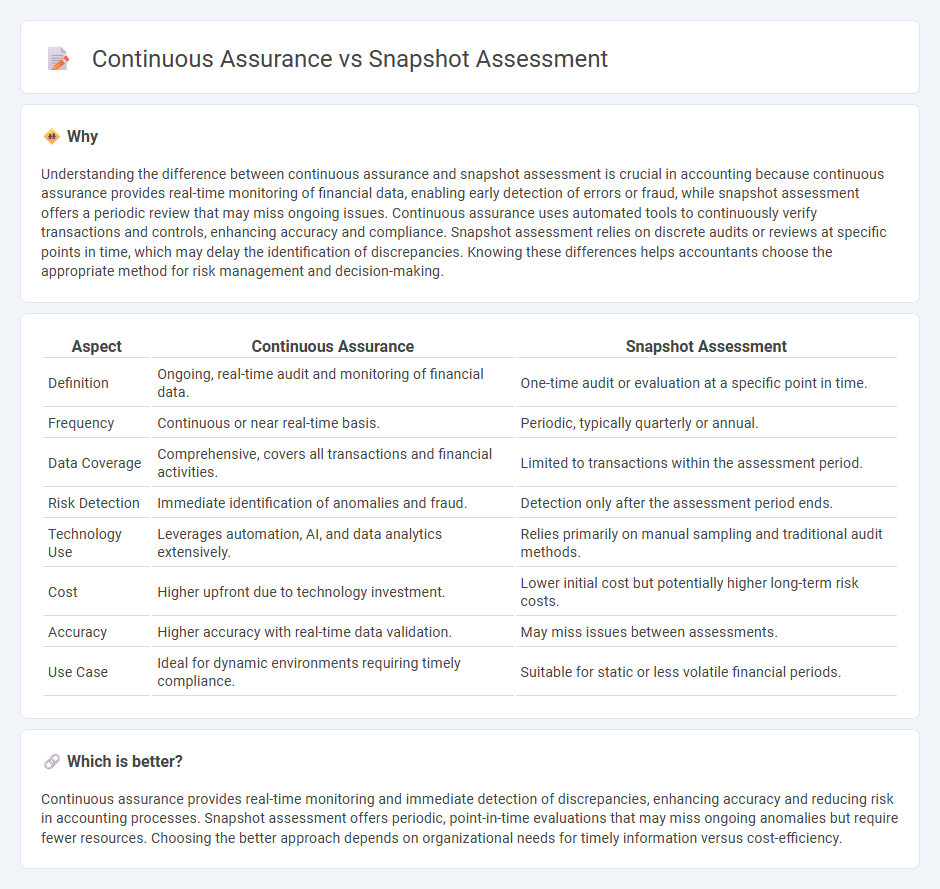
Continuous assurance employs real-time data analysis to provide ongoing verification of financial records, enhancing accuracy and reducing risks in accounting processes. Snapshot assessment captures a specific point in time, offering a periodic evaluation of financial statements but may miss interim anomalies or trends. Explore the advantages and applications of both methods to optimize your accounting strategy.
Why it is important
Understanding the difference between continuous assurance and snapshot assessment is crucial in accounting because continuous assurance provides real-time monitoring of financial data, enabling early detection of errors or fraud, while snapshot assessment offers a periodic review that may miss ongoing issues. Continuous assurance uses automated tools to continuously verify transactions and controls, enhancing accuracy and compliance. Snapshot assessment relies on discrete audits or reviews at specific points in time, which may delay the identification of discrepancies. Knowing these differences helps accountants choose the appropriate method for risk management and decision-making.
Comparison Table
| Aspect | Continuous Assurance | Snapshot Assessment |
|---|---|---|
| Definition | Ongoing, real-time audit and monitoring of financial data. | One-time audit or evaluation at a specific point in time. |
| Frequency | Continuous or near real-time basis. | Periodic, typically quarterly or annual. |
| Data Coverage | Comprehensive, covers all transactions and financial activities. | Limited to transactions within the assessment period. |
| Risk Detection | Immediate identification of anomalies and fraud. | Detection only after the assessment period ends. |
| Technology Use | Leverages automation, AI, and data analytics extensively. | Relies primarily on manual sampling and traditional audit methods. |
| Cost | Higher upfront due to technology investment. | Lower initial cost but potentially higher long-term risk costs. |
| Accuracy | Higher accuracy with real-time data validation. | May miss issues between assessments. |
| Use Case | Ideal for dynamic environments requiring timely compliance. | Suitable for static or less volatile financial periods. |
Which is better?
Continuous assurance provides real-time monitoring and immediate detection of discrepancies, enhancing accuracy and reducing risk in accounting processes. Snapshot assessment offers periodic, point-in-time evaluations that may miss ongoing anomalies but require fewer resources. Choosing the better approach depends on organizational needs for timely information versus cost-efficiency.
Connection
Continuous assurance enhances financial accuracy by providing ongoing monitoring of accounting processes, while snapshot assessment offers a specific point-in-time evaluation of financial statements. Together, they create a comprehensive auditing framework that ensures real-time data integrity and periodic verification. Integrating continuous assurance with snapshot assessments improves risk management and compliance in accounting practices.
Key Terms
Point-in-Time Audit
Snapshot assessment provides a structured evaluation of financial statements at a specific date, offering a static view of an organization's fiscal health. Continuous assurance, on the other hand, integrates real-time data monitoring and automated controls to deliver ongoing assurance beyond the traditional audit period. Explore the detailed benefits and methodologies of point-in-time audits to enhance your auditing strategy.
Real-Time Monitoring
Snapshot assessment provides a periodic evaluation of financial and operational data, offering a static view that may miss emerging risks. Continuous assurance employs real-time monitoring techniques, leveraging automated data analytics and system integration to detect anomalies and ensure ongoing compliance. Explore how real-time monitoring transforms risk management processes for enhanced accuracy and timeliness.
Transactional Data Analysis
Transactional data analysis in snapshot assessment captures specific data points at a single moment, providing a clear but limited view of financial transactions. Continuous assurance leverages real-time data monitoring and automated analytics to identify anomalies and trends throughout the reporting period, enhancing accuracy and risk detection. Explore how continuous assurance transforms transactional data analysis for improved audit quality and operational insights.
Source and External Links
Stage snapshots - NSW Department of Education - Stage snapshots are online assessments that provide an immediate overview of student learning in reading and mathematics for Stages 2 to 4, helping teachers identify strengths and areas for focus based on syllabus outcomes.
Character Skills Snapshot | Enrollment Management Association - The Character Skills Snapshot assesses students' intellectual, intrapersonal, and interpersonal skills to provide a holistic view of a candidate during school admissions, aiming to help schools select and support students based on character strengths and preferences.
Snapshot Assessments | Gateway Technical College - Snapshot assessments in workforce training evaluate current employee or candidate skill levels to help companies customize training, identify gaps, and make informed personnel and development decisions.
 dowidth.com
dowidth.com